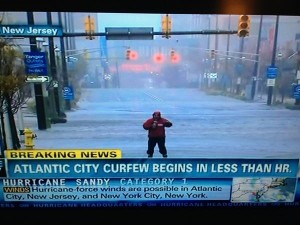From Superstorm Sandy To Climate Action
 Sandy is like a horror film we can’t stop watching: And this “Frankenstorm,” coming right on Halloween, is giving us the best of the worst of storms.
Sandy is like a horror film we can’t stop watching: And this “Frankenstorm,” coming right on Halloween, is giving us the best of the worst of storms.We are glued to the set, knowing exactly what comes next: The weathercasters wade into thigh-deep water; they stand at the ocean’s edge, buffeted by high winds; they shout into the microphone…. It is as if the whole thing is choreographed, like some archetypal play being enacted before our eyes for the one-thousandth time.
We have come to expect the endless parade of men (and they are largely men): mayors, governors, presidents, military leaders, all looking manly, in control, surrounded by more men, looking on, somberly, from behind. What they say is less important (we already know the advice, but, like children, must be told again and again: “Things are bad;” “Don’t take any risks;” “Stay off the roads”) than how they say it, and what the optics are: Does he look presidential? Is he a man in charge? How calm does he sound in the face of catastrophe? We need that “father figure,” it seems, when times are tough. And our media and our politicians willingly oblige.
We are so good at this, in America, so good at responding to the crisis. We cheer on our National Guard, our Coast Guard, our everyday heroes, and then, when the danger has passed, when the tide recedes, we congratulate ourselves and them by digging deep into our pockets and sending money to the Red Cross and the homeless shelters, saluting our men and women in uniform, as though this, and this alone, were the price of admission.
And yet…we are fooling ourselves, again and again, just as our children do every Halloween. This Frankenstorm, can we stop fooling ourselves? Our planet desperately needs us to act like adults and get beyond [just] responding to one storm after another, as though each one were a unique shock, and not related to an overall climate crisis of enormous proportions.
We need our political leaders and weather-casters to end the silence on climate change, to tell us the truth: That these storms will only grow more intense as our oceans warm and the Arctic melts. And we need to start to think long-term, to start claiming responsibility and not blame Mother Nature for our plight. Climate change is upon us, folks, and if this is what a 1 Degree Celsius rise looks like, imagine what a 2, 3, or 4 degree rise looks like.
For leadership, we may have to look beyond our borders, to the Danes or the Germans: They have taken their blinders off, looked around, taken stock of who owns most of the oil and gas in the world, carefully reviewed what Japan is suffering in the wake of Fukushima’s multiple nuclear meltdowns, and both countries have made a firm commitment to going both fossil-fuel-free and nuclear-free. These countries are committed to true energy independence–not the short-lived kind that results from trading one poisonous addiction for another. It is a long slog. Their path does not involve instant gratification nor feel-good heroics. It involves tinkering with different policies–such as Germany’s feed-in tariff and Denmark’s multi-decadal experimentation with wind. It involves committing hundreds of billions of dollars to solving a problem that will ultimately save these countries and their people hundreds of billions of dollars, while saving millions of lives around the world.
There are few heroes in these national dramas. There are plenty of ordinary people, including women, thinking of their children, their grandchildren, and of children on the other side of the planet, understanding that the energy commitments we make today affect the “Frankenstorms” our children will suffer tomorrow.
Can we grow up and out of scaring ourselves to death? Can we move into a long-term push toward the kind of energy future that will not bring real terror to millions around the world? Or will we just put on the costume of Superman and pretend we have saved [Metropolis] yet again while Frankenstorm 2.0 waits around the corner?
You can return to the main Market News page, or press the Back button on your browser.

